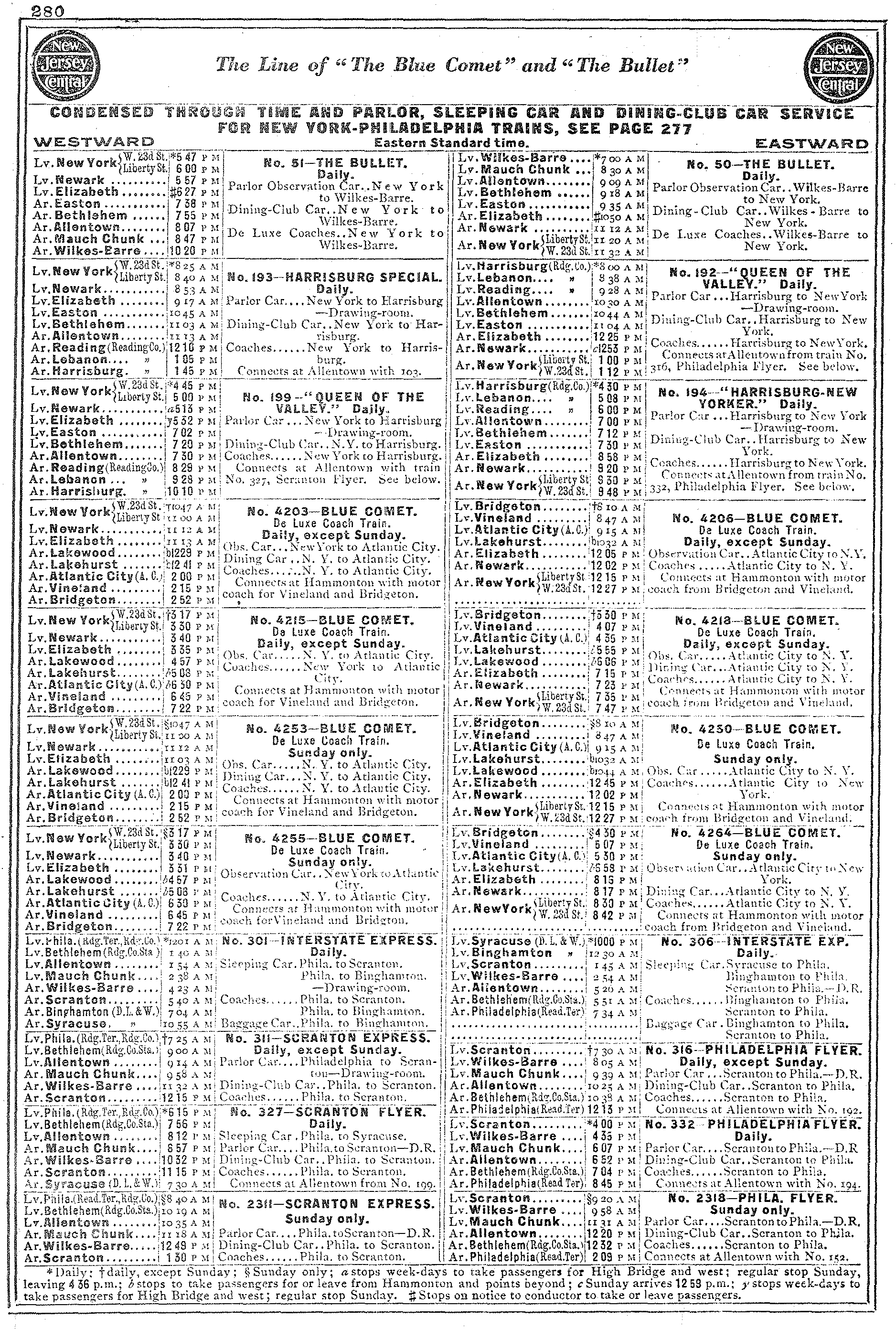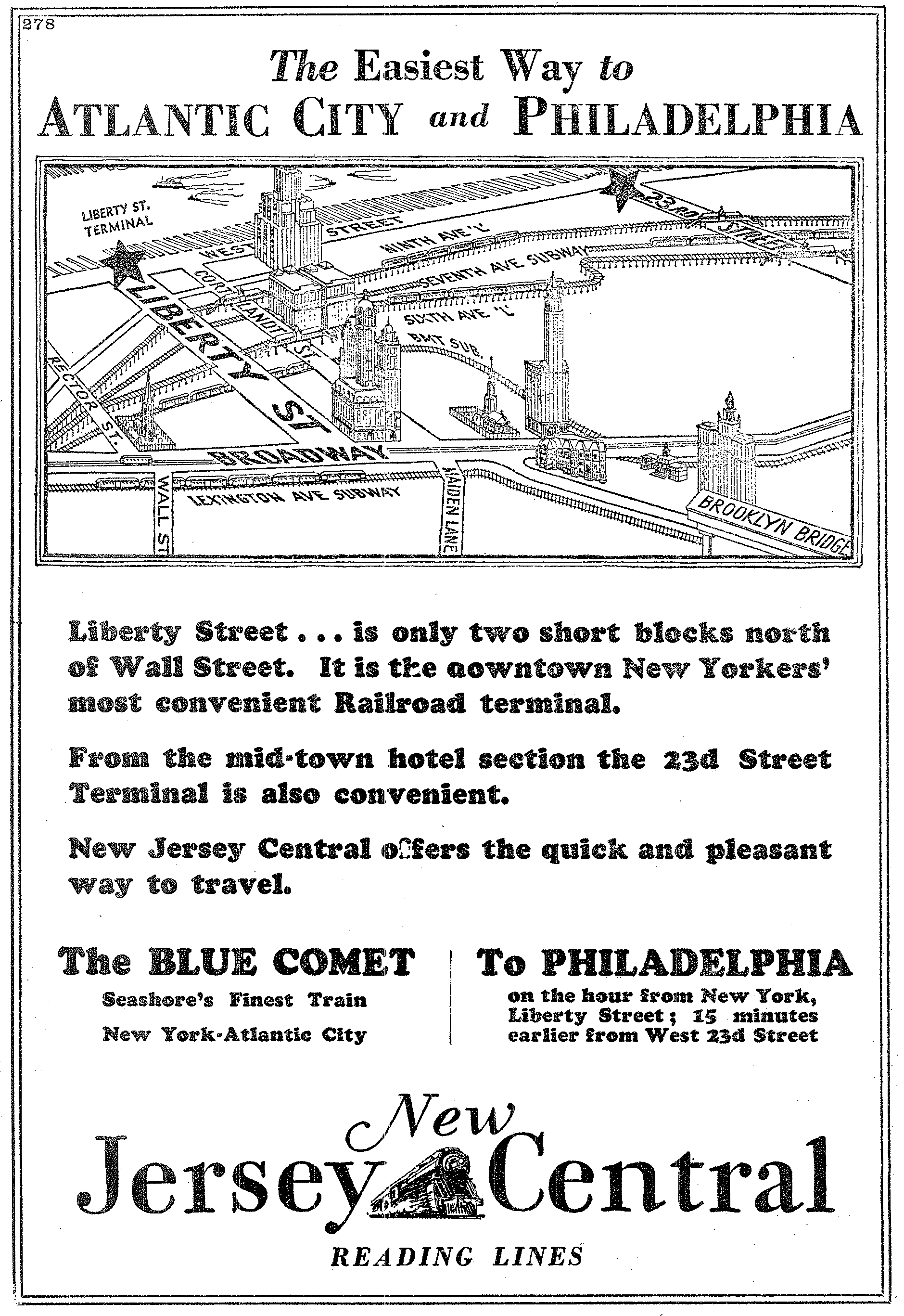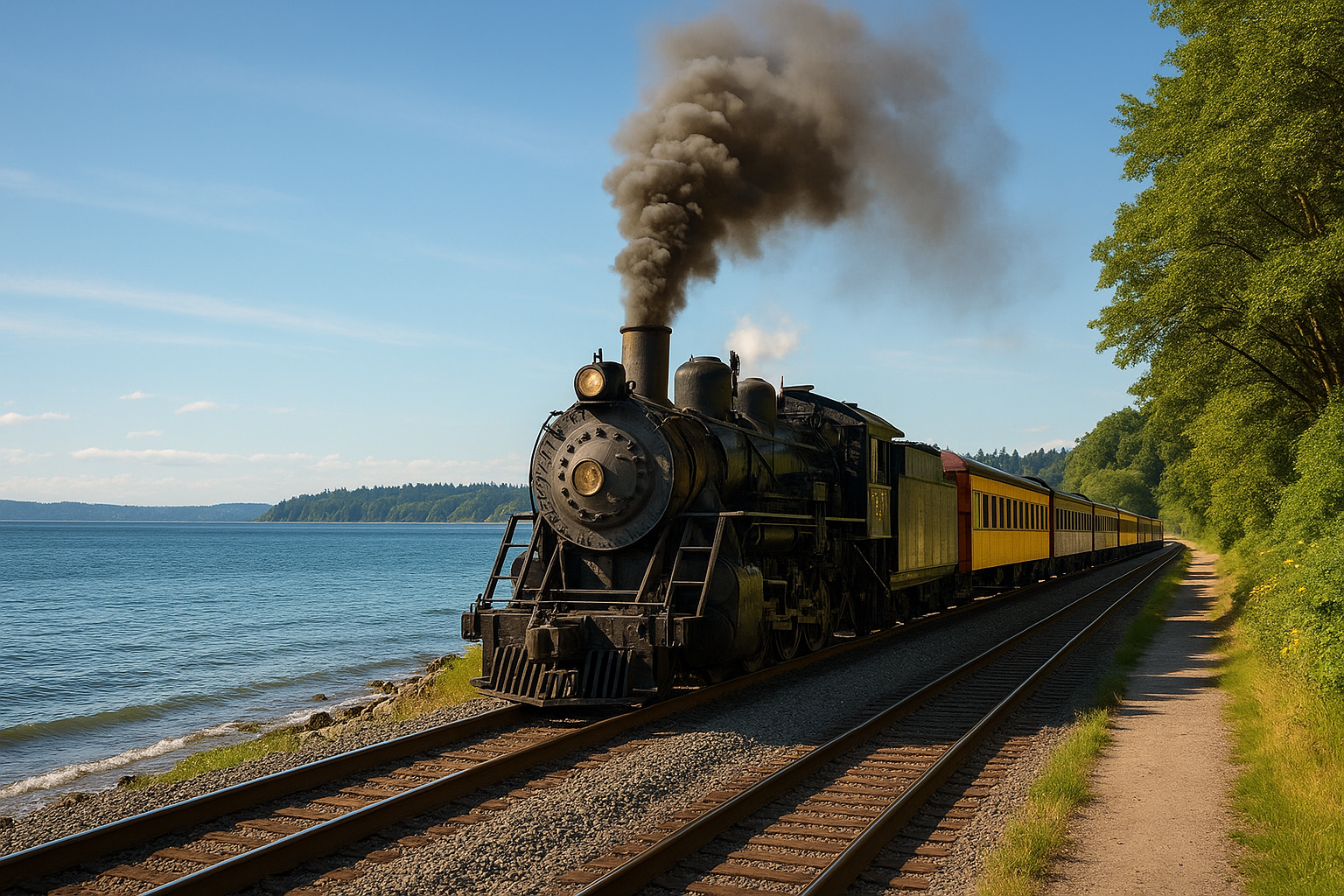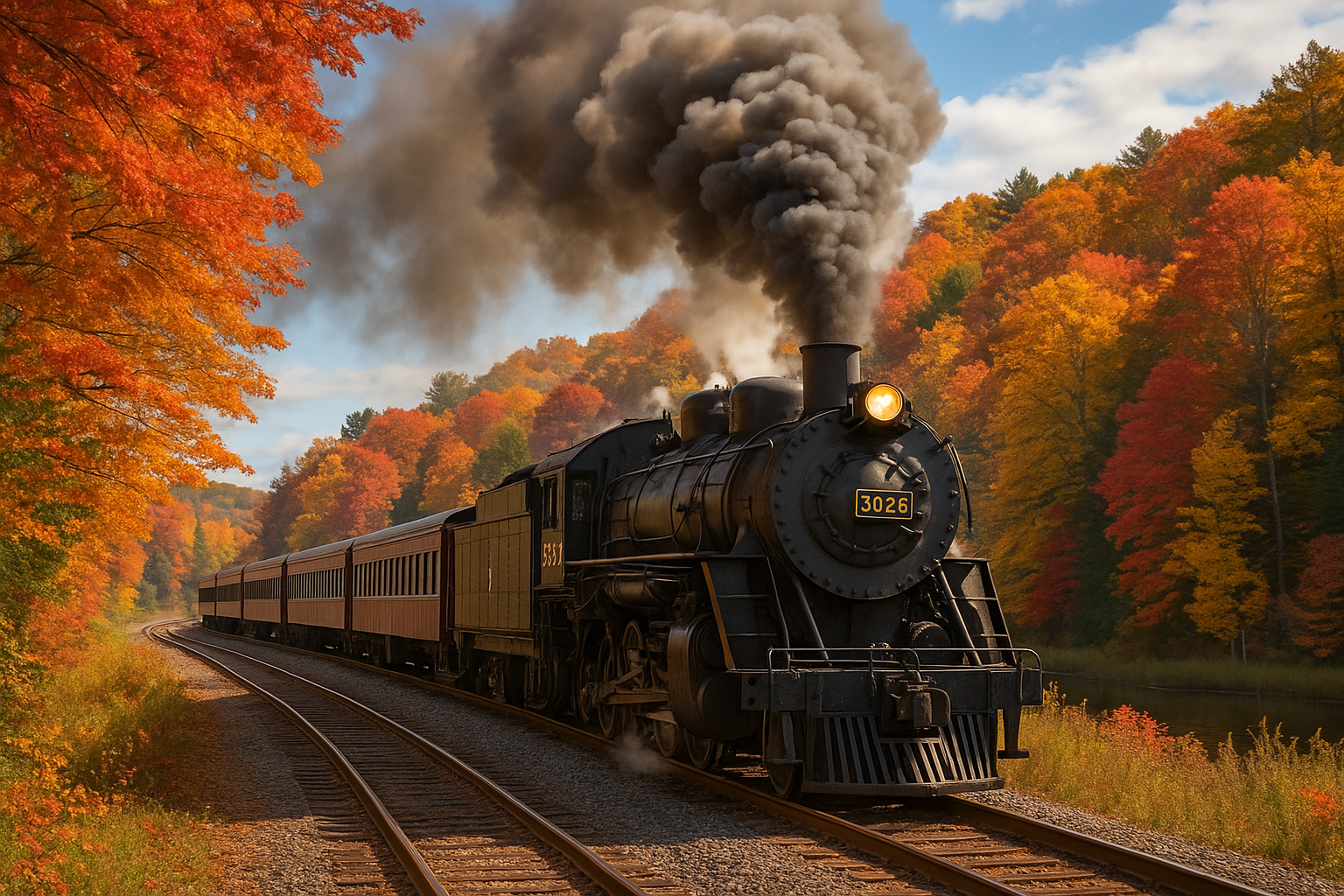The "Blue Comet" (Train): Route, Consist, Timetable
Last revised: September 15, 2024
By: Adam Burns
The Blue Comet, often referred to as "The Seashore's Finest Train," was a prestigious service operated by the Central Railroad of New Jersey (CNJ).
Introduced during the golden age of American rail travel, the Blue Comet is remembered for its luxurious service, art deco design, and the role it played in connecting urban travelers to the Jersey Shore.
This article delves into the rich history of the train, exploring its origins, operation, legacy, and enduring cultural significance.
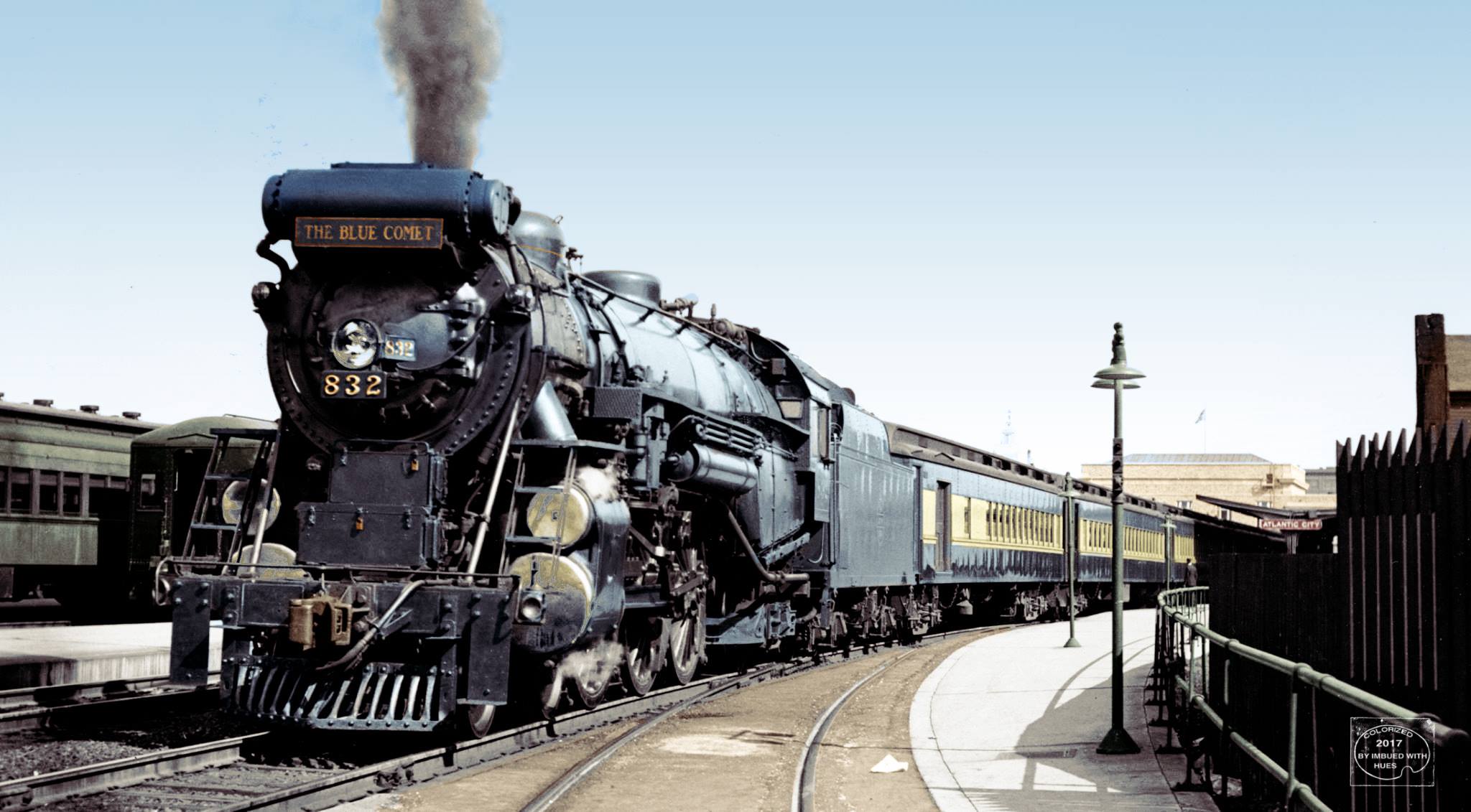 Jersey Central 4-6-2 #832 with the "Blue Comet," wearing its handsome Ultramarine and Packard Blue livery, is seen here at Atlantic City, New Jersey during the 1930s. Photo colorized by Patty Allison.
Jersey Central 4-6-2 #832 with the "Blue Comet," wearing its handsome Ultramarine and Packard Blue livery, is seen here at Atlantic City, New Jersey during the 1930s. Photo colorized by Patty Allison.Origins and Ambition
The Vision Behind the Blue Comet
In the late 1920s, the Central Railroad of New Jersey sought to capitalize on the burgeoning popularity of the Jersey Shore as a premier vacation destination. Atlantic City, in particular, had become renowned for its boardwalk, luxurious hotels, and entertainment venues.
The CNJ envisioned a train service that not only competed with the Pennsylvania Railroad’s established routes but also offered an unparalleled level of comfort and style.
The brainchild of Jersey Central President R.B. White, the Blue Comet was conceptualized as a high-speed, luxury train designed to transport passengers from Jersey City to Atlantic City in style and comfort.
The goal was to create a train that would embody elegance and efficiency, drawing in tourists and boosting the region's appeal.
Naming and Branding
The Blue Comet's name was chosen to evoke images of speed, beauty, and modernity. The train's striking blue color scheme further emphasized these qualities, helping it stand out as a symbol of progress and innovation.
Each car was named after a different comet, enhancing the celestial theme and appealing to the public's fascination with astronomy.
The Train and Its Route
Design and Amenities
The Blue Comet made its inaugural run on February 21, 1929, showcasing a level of luxury and attention to detail that set it apart from other trains of the era.
The train's exterior featured a vibrant blue and cream livery, while the interior boasted art deco designs, plush seating, and state-of-the-art amenities.
The color scheme was a striking combination of ultramarine and Packard Blue, symbolizing the sea, paired with cream, representing the sandy coastal beaches, and accented with nickel.
The train's cohesive aesthetic extended beyond its exterior; tickets were printed in blue, dining car chairs were upholstered in blue linen, and porters were attired in matching blue uniforms.
Boasting a top speed of 100 miles per hour, the Blue Comet was a marvel of its time. The railroad proudly claimed that it was the first train east of the Mississippi River to be equipped with roller bearings, enhancing its ability to start and stop with ease.
The train consisted of several types of cars, including:
1. **Observation Cars:** These cars featured large windows and comfortable seating, allowing passengers to enjoy scenic views of the New Jersey countryside. The rear of the observation car included an open platform, adding to the train’s allure.
2. **Dining Cars:** With elegant dining settings and a fine selection of meals, the dining cars were equipped to provide a first-class dining experience, rivaling the best restaurants.
3. **Coach Cars:** Offering spacious and comfortable seating, the coach cars ensured that even standard ticket holders experienced a superior level of comfort.
The Route
The Blue Comet operated along a route that extended from Communipaw Terminal in Jersey City to Atlantic City. The journey covered approximately 136 miles and included stops at major stations such as Elizabeth, Red Bank, Lakewood, Winslow Junction, and Hammonton.
With a schedule designed for speed and convenience, the Blue Comet completed the journey in about three hours, significantly faster than competing services.
Consist
Service and Operation
Timetable and Schedule
The train operated on a strict timetable, with trains departing from Jersey City and Atlantic City at regular intervals. This consistency made it a reliable option for both leisure travelers and business commuters. The train ran twice daily in each direction, providing ample flexibility for passengers.
November 25, 1929 Timetable
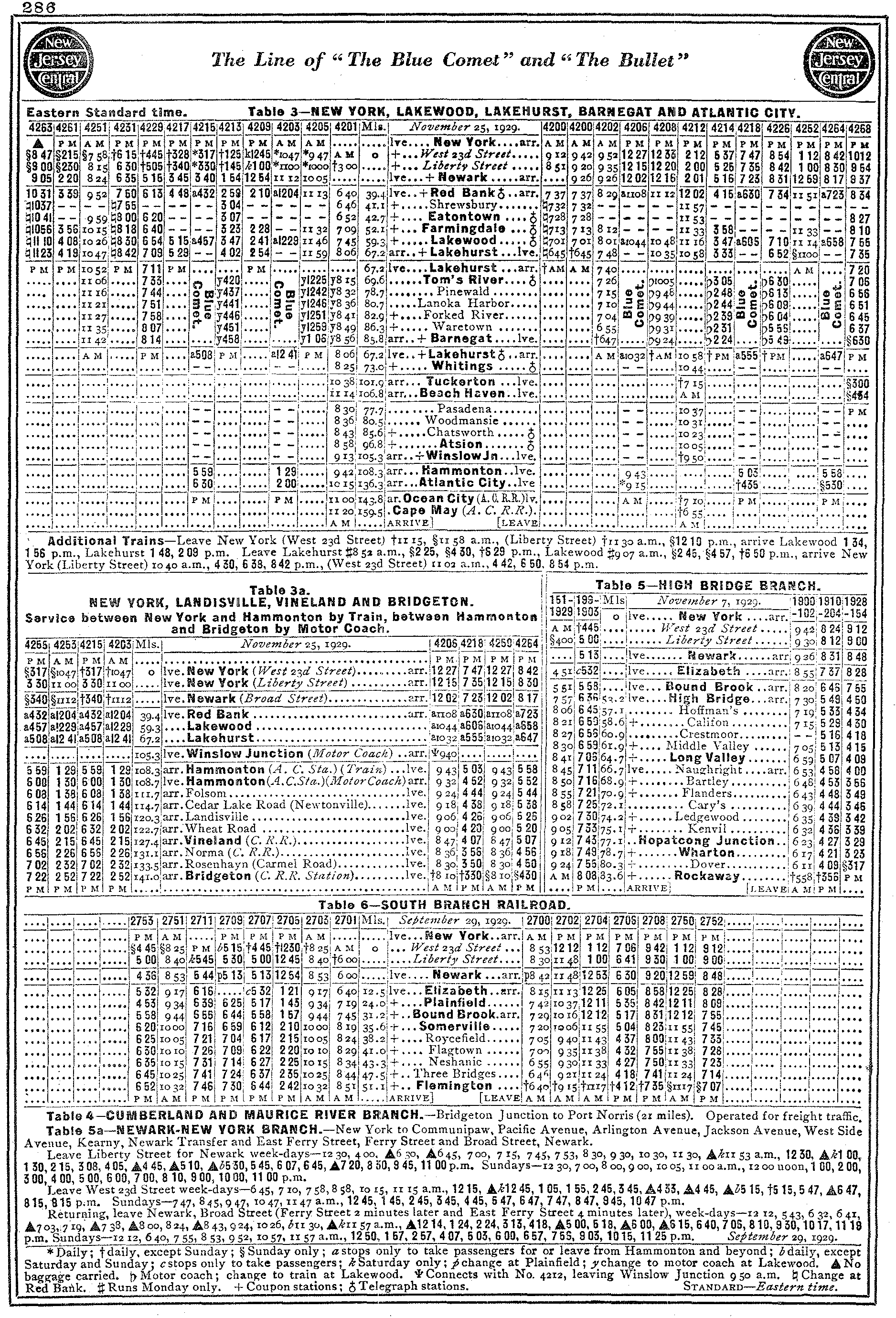
Passenger Experience
From the moment passengers stepped aboard the Blue Comet, they were immersed in an environment of sophistication and comfort.
Uniformed attendants greeted travelers, assisting with luggage and catering to their needs throughout the journey. The dining car menus featured gourmet cuisine, and the observation cars provided breathtaking views, making the trip an experience in itself.
Challenges and Competition
The Great Depression
Despite its initial success, the Blue Comet faced significant challenges during its operation. The onset of the Great Depression in the early 1930s led to a decline in passenger numbers as economic hardships affected travel spending. The luxurious nature of the Blue Comet became less viable in an era when frugality was paramount.
Competition from Automobiles and Buses
The rise of automobiles and bus services presented additional competition, offering travelers an alternative means of reaching the Jersey Shore. As American infrastructure improved, roads and highways became more accessible, further eroding the train’s passenger base.
Weather-Related Incidents
The Blue Comet also encountered several weather-related challenges that affected its operation. One notable incident occurred on August 19, 1939, when the train derailed near Chatsworth during a severe thunderstorm. Though there were no fatalities, the incident highlighted the vulnerabilities of rail travel to natural elements.
Decline and Cessation of Service
Wartime Struggles
The onset of World War II further disrupted rail travel, as resources and priorities shifted towards the war effort. The Blue Comet continued to operate but faced reduced ridership and ongoing financial difficulties. The luxurious amenities that once defined the train were scaled back to adapt to wartime austerity measures.
Final Run
Ultimately, the economic and competitive pressures proved insurmountable. The train made its final run on September 27, 1941, marking the end of an era. The train’s discontinuation reflected broader trends in American transportation, as rail travel increasingly gave way to automobiles and airplanes.
Legacy and Cultural Impact
Preserving History
The legacy of the Blue Comet endures through the efforts of historians, rail enthusiasts, and preservationists. Several cars from the original train have been preserved and restored, displayed in museums and heritage railways to educate future generations about the golden age of rail travel.
Cultural References
The Blue Comet has left a lasting mark on popular culture, featuring in literature, music, and art. Its depiction in various media highlights the train’s status as an icon of elegance and sophistication. The train's unique branding, striking color scheme, and association with luxury have ensured its place in the annals of American rail history.
Heritage Operations
While the original Blue Comet is no longer in service, its spirit lives on through heritage railway operations and themed excursions. Organizations dedicated to preserving rail history occasionally recreate the train's experience, offering passengers a taste of the glamour and excitement that once defined the train.
Conclusion
Despite its relatively short lifespan, the train’s legacy persists, celebrated for its innovation, style, and the memorable experiences it provided.
The train’s vision of connecting people to the Seashore in unparalleled comfort and speed continues to inspire and captivate those who seek to understand the golden age of rail travel.
Today, the story of the Blue Comet serves as a reminder of a bygone era when the journey was as important as the destination. Through preservation efforts, historical accounts, and the passion of rail enthusiasts, the legacy of the Blue Comet endures—promising that the spirit of “The Seashore's Finest Train” will never be forgotten.
Recent Articles
-
Washington's Whiskey Train Rides
Jul 10, 25 03:06 PM
Climb aboard the Mt. Rainier Scenic Railroad for a whiskey tasting adventure by train! -
Maryland's Whiskey Train Rides
Jul 10, 25 01:05 PM
You can enjoy whiskey tasting by train at just one location in Maryland, the popular Western Maryland Scenic Railroad based in Cumberland. -
Connecticut's Whiskey Train Rides
Jul 10, 25 11:03 AM
In this article, we'll take a closer look at these special train rides, explore the magic behind them, and offer tips for anyone looking to embark on this memorable journey.
